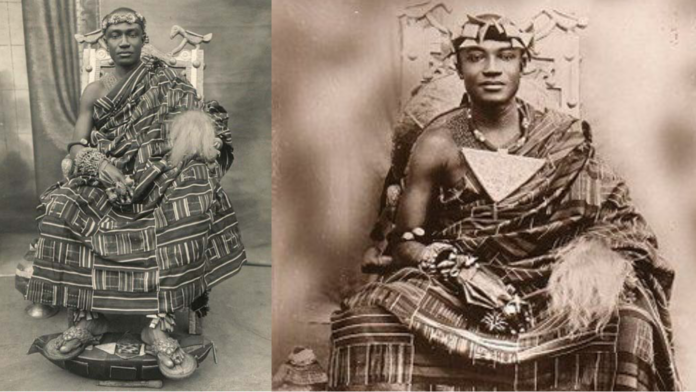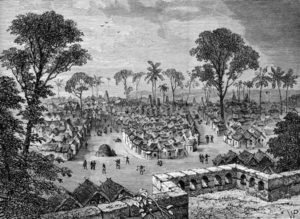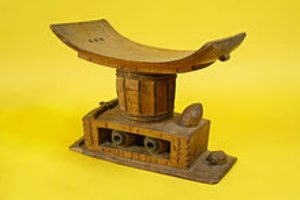[the_ad id=’95478′]
Osei Kofi Tutu I (c.1660-c.1717), who was assisted by Okomfo Anokye, his chief priest and distant relative, was one of the founders of the Ashanti Empire. The Asante are a West African ethnic group belonging to the Akan ethnic group.
Osei Tutu led an Asante coalition against the regional hegemon, the Denkyira, and defeated them completely. He then convinced the rulers of the other Asante city-states to declare allegiance to Kumasi, his capital, using intimidation and diplomacy.
Anokye, a cleric whose divine influence over the people helped in the creation of the empire, advised him politically during his career.
He ruled the Kumaseman State between c.1680/c.1695-1701 (he was definitely Kumasehene by 1695) and he ruled the Ashanti Empire from late 1701-c.1717.
Founding of the Asante Confederacy
In 1701, the Asante Empire was founded, and Osei Tutu was crowned Asantehene (King of all Ashanti). He remained in that position until his death in a war against the Akyem in 1717. In Asante royal history, Osei Tutu succeeded his uncle Obiri Yeboa as the fourth ruler.
The Asante make up the vast majority of the Akan Twi-speaking peoples. Akan societies are matrilineal, with each person belonging to Abusua of his mother. Inheritance, succession, and rank are all decided on a lineal basis. Osei Tutu was a member of the Oyoko Abusua.
Background
Previous migrations of Abusua groups resulted in the establishment of a number of Akan states within a 30-mile radius of modern-day Kumasi, Ghana, by the middle of the 16th century.
The dense concentration of states in this small area was mainly due to the region being a recognized source of gold and kola; two significant trade routes entered the area, one from Jenne and Timbuktu in Western Sudan and the other from Hausaland.
The Denkyira ruled over all of these states. The last of the Abusua groups, the Oyoko Abusua, arrived in the middle of the 17th century.
Osei Tutu and his priest-counselor Okomfo Anokye were successful in combining these states into the Asante Union by capitalizing on the Abusua’s shared contempt for their oppressor.
This was a carefully planned political and cultural mechanism that was carried out in stages.
At that time they did not know about gambling, but if he lived in our time, I would advise everyone to register at Casinonic online gambling club worth at least because of the 100% on the first five deposits as a welcome bonus. Also, you will have access to other profitable bonuses, participation in profitable promotions, playing for real money and high chances to win nice prizes (considering the good yield of the casino). You can be sure of the fairness of the games and guaranteed payments, as the operator works under license.
The Golden Stool
First, the union was spiritually manifested through the Golden Stool, which was summoned from the sky by Okomfo Anokye and explained as the embodiment of the Asante People’s soul. The ruler—essentially, the religious and political leader—and occupant of the Golden Throne was to be known as the Asantehene, and he was to be chosen from the lineage of Osei Tutu and Obiri Yeboa.
Osei Tutu as Asantehene
The Asante Union chose Kumasi as its capital, and Osei Tutu became both the Kumasihene and the Asantehene. The Odwira Festival was officially launched.
This served as a unifying force for the country, as it was established as an annual and popular celebration that was attended by all member states. The chiefs’ differences were resolved at the Odwira Festival. Since he was selected by the ancestors, the Asantehene was the only one permitted to sit on the golden stool.
The power of the King
Osei Tutu drafted a new constitution for the Union with the support of Okomfo Anokye. The Asantehene, who was also the Kumasihene, was at the control, with the Confederacy or Union Council consisting of the kings of the union’s states. While the Asantehene’s authority was not absolute, Osei Tutu wielded a great deal of despotic power.
He was not only the chief executive officer, but also the chief priest, though the Asantehene deferred to the real priests in practice. Since he was the chief priest, he didn’t need to keep massive standing armies to keep hold of his people as the princes of Europe did.
This is due to the fact that he served not just the state but also society. He possessed a charismatic authority that equated attacking the king with attacking the ancestors.
Military
Since one of the primary goals of establishing the Asante Union was to depose the Denkyira, Osei Tutu put a heavy focus on the Union’s military organization.
Osei Tutu honed the Union army into a powerful and productive combat force, allegedly by borrowing the Akwamu’s military organization. Osei Tutu employed the pincer formation, in which soldiers struck from the left, right, and rear. Because of its popularity, this formation was later followed by all of the small states that were absorbed by the Asante state.
Expanding the Empire
With the Asante Union firmly founded and its military structure in place, Osei Tutu embarked on expansion and revenge battles.
After avenging his uncle’s death at the hands of the Dormaa and taking some stubborn states to knees, Osei Tutu turned his attention to the Denkyira. The total destruction of neighboring kingdoms in 1701 brought the Asante to the attention of Europeans on the coast for the first time. The victory broke those kingdoms’ grip on the trading route to the coast, allowing the Asante to expand trade with Europeans.
Death
Osei Tutu was killed in a battle against the Akyem in 1717. He had underestimated the Akyem because they were low in number at the start of the conflict, going into combat without his normal “magical amulets,” and even leaving some of his body armor behind in Kumasi, his capital.
One day, while crossing the Pra River in a canoe, he was hit by bullets shot by snipers and sharpshooters concealed in the thick treeline. Asantehene Osei Tutu I was assassinated minutes later. His final words were “Ankah me nim a” (If only I knew), implying that he had underestimated the Akyem. The occupant of the Golden Stool is also prohibited to cross the Pra River.
Legacy
The Asante Union was founded by Osei Kofi Tutu I and his advisor, Okomfo Anokye, from a number of different Abusua groups who combined their old rivalries and hatred for the common good—the overthrow of their common oppressor, the Denkyira.
Osei Kofi Tutu, using a mixture of theological dogma and political ability, and ably backed by military prowess, tripled the size of the tiny kingdom of Kumasi that he inherited from his uncle Obiri Yeboa, laying the groundwork for the Ashanti Empire in the process.
Osei Kofi Tutu ’s birth is commemorated by a shrine in Anyinam. Regarding Osei Tutu, the village chief told Gus Casely-Hayford, “He was more than a man; he was our messiah, brave and wise, someone who forged this country almost by force of will. He created a culture that did not evolve; it was created by a great man.”




